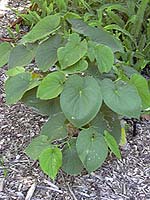Kava: A Healthy Way to Relieve Stress

Piper methsyticum, or Kava, has become one of the most popular herbs in recent years.
The Kava plant has a large root and is related to the pepper family of shrubbery. Largely found in the South Pacific, it has evolved from over 3,000 years of human cultivation.
Due to Kava’s recent popularity, the herb is becoming a victim of supply and demand, with the supply decreasing and the demand increasing. Kava takes up to five years to cultivate, which makes it difficult for suppliers and growers to keep up with the public’s desire for the herb.
Kava was used by the Germans in the 1890s for pharmaceuticals relating to blood pressure; before then, it was utilized by the Polynesians. The natives used a brew from the root and leaves said to be as cherished as wine was with the Europeans. Kava has been used to treat anxiety/nervous disorders, migraines, and bladder problems.
Today, we use and know Kava as a non-addictive way to sooth nerves and relax. In small, recommended doses, no side effects have been found for Kava. However, large dosages of Kava can have a sedative effect, which means that one should avoid alcohol, driving, and operating heavy machinery when taking heavy amounts.
The “kava” lactones, which are the plant chemicals that produce the desired effects, have been studied in the use of relaxing stiff muscles by blocking signals in the user’s nerves.
A 1993 double-blind case study conducted by scientist H.J. Heinze compared the effects of Kava versus the effects of  . The sedating effects found with the . The sedating effects found with the  users were not found with the Kava users; they were able to perform tasks users were not found with the Kava users; they were able to perform tasks  users are told to avoid. users are told to avoid.
A 1996 German study revealed that doses of one hundred milligrams, taken up to three times a day, relieved anxiety in a group of 58 people. Scientists at Jena University in Germany gave 101 study participants either Kava or a placebo for 25 weeks. The individuals who took Kava became less anxious than the placebo users. The researchers and scientists concluded that doctors should consider Kava when treating patients with anxiety disorders.
Kava comes prepared as caplets, capsules, tablets, tinctures, teas, and dry bulk. The “Pill” type available is mostly standardized, so you should read labels and check the manufacturer. If it doesn’t say “standardized” on the label or list Kava as the first (and preferably only) ingredient, try another brand. Remember, follow doses listed on the label, and if you are unsure of something, ask the nutritionist or herbalist in your health store.
Kava’s reputation is growing for a variety of reasons. It has been said that Kava produces a hallucinogenic effect or, that it mimics some illegal drugs. That is not the case. It should be sought out only for its intended use: the soothing of nerves.
Don’t take Kava if you are pregnant, lactating, or in a depressive state. Depression is different from anxiety, and Kava does not have positive results on the depressed individual.
Kava may help sooth your nerves and the daily pressures associated with anxiety. Since anxiety is such a prevalent disorder, the prospect of treating it in a non-addictive way has people beating a path to their local health food stores. Try and get in line early, folks, because when demand is greater than supply, shelves become empty and prices go up — and spending a lot of money will only make you more anxious.
Article by Stephen Chaleff.
|